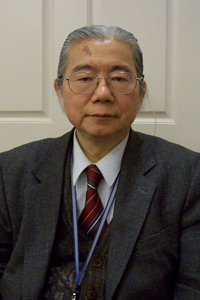2548
Scientific Program

Yoshiaki Omura
International College of Acupuncture & Electro-therapeutics, USA
Title: Basic principles of Bi-Digital O-Ring test
Biography:
Yoshiaki Omura has received his Oncological Residency Training at Cancer Institute of Columbia University and Doctor of Science Degree through research on
Pharmaco-Electro-Physiology of Single Cardiac Cells in vivo and in vitro from Columbia University.
Abstract
Bi-digital O-ring test (BDORT) consists of following four major principles: (1) When abnormal part of the body is given minute mechanical or optical stimulation, if the area is normal, O-ring made
between thumb and one of the selected fingers can be opened easily by examiner’s O-ring in the presence of abnormality (with only exception being thymus gland where normally it is negative). When one O-ring opens it is called (-)1 and if it doesn’t open it is (+)1. (+)
indicates degree of normal condition, (2) Highly sensitive electromagnetic field (EMF) resonance phenomenon between two identical molecules with identical weight separated within distance of 10 meters, (3) When beneficial substance is taken or simply held in the palm, if it is harmful, O-ring will open and if it is beneficial then O-ring becomes stronger and increases in positive value and (4) When identical molecules are placed on the pathway of laser beam, information on the molecular structure and amount will be transmitted bi-directionally towards direction laser beam is going and direction where laser beam is coming from. These principles were discovered by the author who was also doing part-time graduate experimental physics while doing residency work as an
oncological surgery resident physician at Cancer Institute at Columbia University. The method was successfully used for detection of various cancers including pancreatic cancer before standard laboratory tests could detect. This method was given US Patent in 1993. Using BDORT, many difficult medical problems can be rapidly and non-invasively screened or diagnosed by the following methods without taking any blood or biopsies: (1) Using accurate organ representation area maps of various parts of the body, particularly with face including eyebrows, alars of nose, upper and lower lips and abnormalities such as cancer can appear visibly (as deep crease or pigmentation) or non-visibly, (2) 1-page “mouth, hand and foot writing form” which requires 5~10 minutes for patients to complete form. Using this method without knowing any information on the patient, many abnormal conditions, including cancers, can be detected non-invasively and (3) using rapidly changing QRS Complex or slowly rising part of T-wave, most cancers can be detected and many other medical problems can be detected non-invasively. Once diagnosis of patient’s problem is established, safe, effective, individualized treatment can be found for each individual patient. For dentists, safe, effective, dental materials can be selected before installing harmful, BDORT strong (-) substances with invisible infections.
- Oral medicine
- Diagnosis and Prevention of Oral Disease
- Oral and Maxillofacial Surgery
- Orthodontics and Dental Implants
- Prosthodontics
- Oral and Dental Health
- Periodontics and Oral Hygiene
- Restorative Dentistry and Endodontic
- Cosmetic Dentistry
- Oral Oncology
- Dental Public Health and community dentistry
- Radiology
- Focal infection
- Diabetes and Periodontal disease
- Bi-Digital O-Ring Test (BDORT)
- Dementia and Denture
- Skin care, metal allergies around oral area
- Sports dentistry
- Occlusal treatment
- Electromagnetic waves and dentistry

